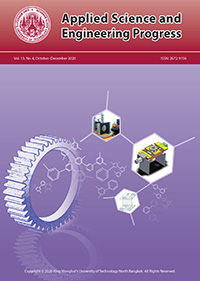Palletizing Robot Application in the Corrugated Box Industry
Main Article Content
Abstract
There is a widespread use of corrugated boxes containers in Thailand, nowadays. There was a 13% increase in the use of corrugated boxes which is equivalent to 23,773 tons from 2016 to 2017. Corrugated boxes production is mostly automated; however, these are still stacked manually on the pallets for transportation. Two workers are usually needed to lift the bundles of boxes weighing 8.50 kg. The average production per day is 50,000 pcs. or 5,000 bundles with a total weight of 42,500 kg and a pallet stacking height of 2,700 mm. The aim of this study is to use the 4-axis robot arm with an external servo motor to substitute the labor-intensive palletizing tasks thereby improving the overall production and cycle time of repetitive tasks in industrial systems. Through the application of the palletizing robot, the operation of the system can easily be setup by just one operator. Users can easily operate and modify the width, length, and height of the boxes. The robotic simulation was programmed through the formulated equations that finds the position of boxes on the pallet to create its moving path. The robot works together with another machine. Experiments was done in order to determine moving path. Results showed that cycle time improved to 8.63% with a maximum error of ± 5 mm from the real position.
Article Details
References
[2] S. Gallagher and J. R. Heberger, “The effects of operator position, pallet orientation and palletizing condition on low back loads in manual bag palletizing operations,” International Journal of Industrial Ergonomics, vol. 47, pp. 85–91, 2015.
[3] W. Sriboon and B. Chanasak, Mathematics of Engineerings and Scientists. KMUTNB, Bangkok, Thailand, 2011 (in Thai).
[4] Packaging Industrial Intelligence Unit, “Report monthly packing list on august,” Packaging Industrial Intelligence Unit, Bangkok, Thailand, 2017 (in Thai).
[5] COMAU Robotics services, “Programming language manual system software Rel. 2.30.xx,” COMAU Robotics services, Grugliasco, Italian, 2014.
[6] J. J. Craig, Introduction to Robotics Mechanics and Control, 2nd ed. New Jersey: Prentice Hall, 1989, pp. 390–407.
[7] COMAU Robotics services, “SMART5 PAL 180- 3.1 technical specifications,” COMAU Robotics services, Grugliasco, Italian, 2014.
[8] M. Aburaia, E. Markl, and K. Stuja, “New concept for design and control of 4 axis robot using the additive manufacturing technology,” in Proceedings 25th DAAAM International Symposium on Intelligent Manufacturing and Automation, 2014, pp. 1365–1369.
[9] S. N. Yu, S. J. Lim, M. K. Kang, C. S. Han, and S. R. Kim, “Off-line robot palletizing simulator using optimized pattern and trajectory generation algorithm,” in Proceedings 2007 IEEE/ASME International Conference on Advanced Intelligent Mechatronics, 2007, pp. 1–6.
[10] How Products Are Made. (2018, Jun.). Corrugated Cardboard. How Products Are Made. Philadelphia, USA [Online]. Available: http://www.madehow. com/Volume-1/Corrugated-Cardboard.html


